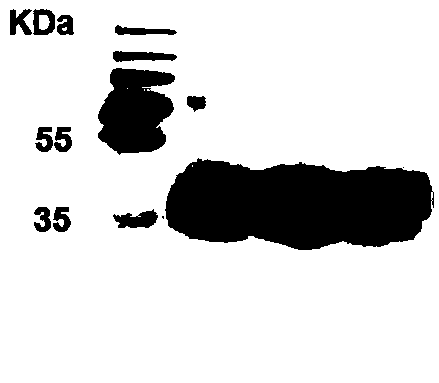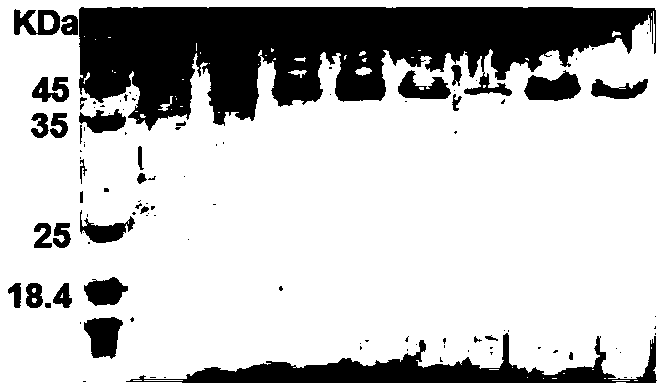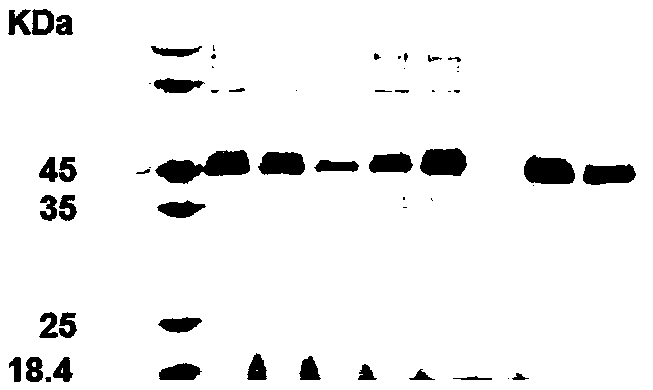Luciferase fluorescence-complementary system, and preparation method and application thereof
A luciferase and system technology, applied in the field of biochemistry, can solve the problems of limited dual fluorescence complementary technology, poor efficiency of dual fluorescence complementary technology, etc.
- Summary
- Abstract
- Description
- Claims
- Application Information
AI Technical Summary
Problems solved by technology
Method used
Image
Examples
Embodiment 1
[0067] Example 1 Protein pair SidM / DrrA and preparation of Rab1 fragment and Gaussia luciferase fragment fusion gene expression vector
[0068] The preparation method of the fusion gene expression vector is as follows:
[0069] (1) The luciferase N-terminal fragment NGluc was introduced at the C-terminal of Rab1, and a flexible long peptide chain linker (GGGGS) was introduced between the two 2 , and introduce a purification tag His6 tag at the C-terminus of the fusion;
[0070] The PCR reaction system is: 25 μL 2×Taq Master Mix, 1 μL DNA template pCDNA3.1-Rab1-linker-NGluc, 2 μL upstream primer (10 μM), 2 μL downstream primer (10 μM), and supplemented with water to 50 μL;
[0071] The primers used to introduce the luciferase N-terminal fragment NGluc at the C-terminal of Rab1 are:
[0072] The sequence of the upstream primer SEQ ID NO:1 is:
[0073] 5'AAACGGATCTCTAGCGAATTCGCCACCATGGAGACAGACACACTCCTGCTATGGGTACTGCTGCTCTGGGTTCCAGGTTCCACTGGTGACTACAAGGACGAGAACCCCCGAGTACGACTACCT ...
Embodiment 2
[0091] Compared with Example 1, except that the luciferase C-terminal fragment Cgluc is introduced at the C-terminus of SidM / DrrA, other conditions are the same as in Example 1;
[0092] The PCR reaction system is: 25 μL 2×Taq Master Mix, 1 μL DNA template SidM / DrrA-linker-CGluc, 2 μL upstream primer (10 μM), 2 μL downstream primer (10 μM), and supplemented with water to 50 μL;
[0093] The primers used to introduce the C-terminal fragment CGluc at the C-terminal of SidM / DrrA are:
[0094] The upstream primer SEQ ID NO:7 is as follows:
[0095] 5'AAACGGATCTCTAGCGAATTCGCCACCATGGAGACAGACACACTCCTGCTATGGGTACTGCTGCTCTGGGTTCCAGGTTCCACTGGTGACTACAAGGACGAG CCCTACAGCGACGCTAAGG 3';
[0096] The downstream primer SEQ ID NO:8 is as follows:
[0097] 5'GAGGTCGAGGTCGGGGGATCCTTAATGGTGATGGTGATGATGGTCACCACCGGCCCCCTTGATCTT 3'.
Embodiment 3
[0098] Example 3 Recovery and Subculture of HEK293F Cells
[0099] Quickly take out the HEK293F cell line from the liquid nitrogen tank to revive the cells, put them in a 37°C water bath and shake slowly until they melt, transfer the cells into a centrifuge tube in an ultra-clean bench, centrifuge at 1000rpm for 5min, discard the supernatant, and lightly shake it with your fingers. Pop the bottom of the centrifuge tube to disperse the cells, add 2mL of medium, and gently blow the cells with a pipette gun to disperse the cells; transfer the cells to a shake flask, and add HEK293F basal culture to culture in a carbon dioxide incubator;
[0100] After 2 days, observe the growth of the cells and count them under the microscope. If the cell density reaches 2-3×10 6 cells / mL, it means that the cells enter the logarithmic growth phase and should be subcultured;
[0101] Use a pipette to gently blow the cell suspension cultured in the shake flask and quickly transfer it to a centrifu...
PUM
 Login to View More
Login to View More Abstract
Description
Claims
Application Information
 Login to View More
Login to View More - R&D
- Intellectual Property
- Life Sciences
- Materials
- Tech Scout
- Unparalleled Data Quality
- Higher Quality Content
- 60% Fewer Hallucinations
Browse by: Latest US Patents, China's latest patents, Technical Efficacy Thesaurus, Application Domain, Technology Topic, Popular Technical Reports.
© 2025 PatSnap. All rights reserved.Legal|Privacy policy|Modern Slavery Act Transparency Statement|Sitemap|About US| Contact US: help@patsnap.com



